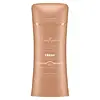What's inside
What's inside
 Key Ingredients
Key Ingredients

 Benefits
Benefits

 Concerns
Concerns

 Ingredients Side-by-side
Ingredients Side-by-side

Aluminum Zirconium Tetrachlorohydrex Gly 15.4%
AstringentCyclopentasiloxane
EmollientStearyl Alcohol
EmollientHydrogenated Castor Oil
EmollientPPG-14 Butyl Ether
Skin ConditioningDimethicone
EmollientTalc
AbrasiveParfum
MaskingSilica
AbrasivePEG-8 Distearate
EmulsifyingAllantoin
Skin ConditioningMaltodextrin
AbsorbentCorn Starch Modified
AbsorbentBHT
AntioxidantAlpha-Isomethyl Ionone
PerfumingBenzyl Benzoate
AntimicrobialCitronellol
PerfumingCoumarin
PerfumingGeraniol
PerfumingHexyl Cinnamal
PerfumingHydroxycitronellal
PerfumingIsoeugenol
PerfumingLinalool
PerfumingAluminum Zirconium Tetrachlorohydrex Gly 15.4%, Cyclopentasiloxane, Stearyl Alcohol, Hydrogenated Castor Oil, PPG-14 Butyl Ether, Dimethicone, Talc, Parfum, Silica, PEG-8 Distearate, Allantoin, Maltodextrin, Corn Starch Modified, BHT, Alpha-Isomethyl Ionone, Benzyl Benzoate, Citronellol, Coumarin, Geraniol, Hexyl Cinnamal, Hydroxycitronellal, Isoeugenol, Linalool
Aluminum Sesquichlorohydrate 12.2%
AstringentWater
Skin ConditioningC12-15 Alkyl Benzoate
AntimicrobialCyclopentasiloxane
EmollientSynthetic Wax
AbrasiveGlycerin
HumectantCalcium Chloride
AstringentCetyl PEG/PPG-10/1 Dimethicone
EmulsifyingGlycine
BufferingParfum
MaskingHelianthus Annuus Seed Oil
EmollientButyrospermum Parkii Butter
Skin ConditioningCocos Nucifera Oil
MaskingHibiscus Rosa-Sinensis Flower Extract
HumectantBenzyl Alcohol
PerfumingBenzyl Benzoate
AntimicrobialBenzyl Salicylate
PerfumingCitral
PerfumingCoumarin
PerfumingHydroxycitronellal
PerfumingLimonene
PerfumingAluminum Sesquichlorohydrate 12.2%, Water, C12-15 Alkyl Benzoate, Cyclopentasiloxane, Synthetic Wax, Glycerin, Calcium Chloride, Cetyl PEG/PPG-10/1 Dimethicone, Glycine, Parfum, Helianthus Annuus Seed Oil, Butyrospermum Parkii Butter, Cocos Nucifera Oil, Hibiscus Rosa-Sinensis Flower Extract, Benzyl Alcohol, Benzyl Benzoate, Benzyl Salicylate, Citral, Coumarin, Hydroxycitronellal, Limonene
Ingredients Explained
These ingredients are found in both products.
Ingredients higher up in an ingredient list are typically present in a larger amount.
Benzyl Benzoate is usually created from the condensation of benzoic acid and benzyl alcohol. It is used as a preservative, solvent, and has a floral/balsamic scent in large amounts.
As a preservative, Benzyl Benzoate works against bacteria and fungus. It is often used to treat scabies and lice in medicine.
Solvents are used to keep ingredients together in a product. They can help dissolve ingredients to stable bases or help evenly distribute ingredients throughout the product.
Due to its fragrance, Benzyl Benzoate can be sensitizing and may cause contact dermatitis. It is a known EU allergen. We recommend speaking with a professional if you have any concerns.
Benzyl Benzoate can be naturally found in cranberries and peaches.
Learn more about Benzyl BenzoateCoumarins are a group of substances found naturally in plants. There are over 1300 types of coumarins identified. It has a natural vanilla scent.
Coumarin is an identified EU known allergy, meaning it may cause an allergic reaction when applied to the skin.
In many countries, coumarin is banned as a food additive. However, it can be found in soaps, tobacco products, and some alcohol drinks.
Plants use coumarins as a chemical defense. Some plants that have coumarins include lavender, tonka beans, and yellow clovers.
Learn more about CoumarinCyclopentasiloxane, or D5, is a silicone used to improve texture of products and trap moisture.
D5 is considered lightweight and volatile. Volatile means it evaporates quickly after application. Once evaporated, D5 leaves a thin barrier that helps keep skin hydrated.
It is also an emollient. Emollients help soften the skin and prevent water loss. Silicones create a silky texture in products. D5 helps other ingredients become more spreadable.
Studies show D5 is safe to use in skincare products. We recommend speaking with a skincare professional if you have concerns.
Learn more about CyclopentasiloxaneHydroxycitronellal is a fragrance created from citronellal. The smell of hydroxycitronellal is often described as "citrus-like" or "melon-like".
Hydroxycitronellal is a known EU allergen and may cause irritation when applied to the skin.
Parfum is a catch-all term for an ingredient or more that is used to give a scent to products.
Also called "fragrance", this ingredient can be a blend of hundreds of chemicals or plant oils. This means every product with "fragrance" or "parfum" in the ingredients list is a different mixture.
For instance, Habanolide is a proprietary trade name for a specific aroma chemical. When used as a fragrance ingredient in cosmetics, most aroma chemicals fall under the broad labeling category of “FRAGRANCE” or “PARFUM” according to EU and US regulations.
The term 'parfum' or 'fragrance' is not regulated in many countries. In many cases, it is up to the brand to define this term.
For instance, many brands choose to label themselves as "fragrance-free" because they are not using synthetic fragrances. However, their products may still contain ingredients such as essential oils that are considered a fragrance by INCI standards.
One example is Calendula flower extract. Calendula is an essential oil that still imparts a scent or 'fragrance'.
Depending on the blend, the ingredients in the mixture can cause allergies and sensitivities on the skin. Some ingredients that are known EU allergens include linalool and citronellol.
Parfum can also be used to mask or cover an unpleasant scent.
The bottom line is: not all fragrances/parfum/ingredients are created equally. If you are worried about fragrances, we recommend taking a closer look at an ingredient. And of course, we always recommend speaking with a professional.
Learn more about Parfum